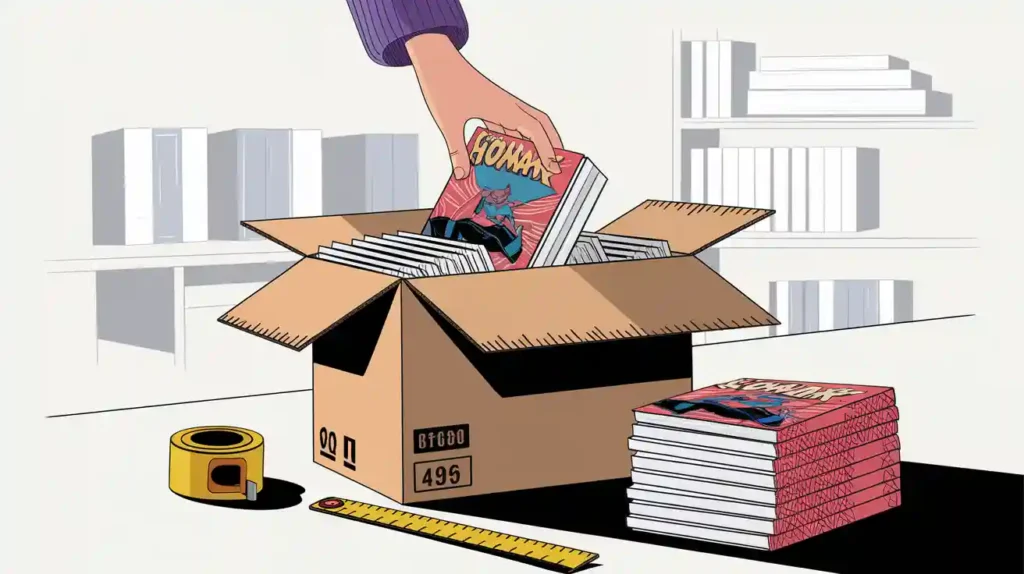
Standard comic book boxes measure about 15 to 16.75 inches long, 7.5 to 8.25 inches wide, and 11 to 12 inches tall, holding up to 180 comics. Box size depends on whether the collection includes modern, silver age, or golden age issues, as each type varies in width and fit.

Collectors often choose custom or decorative comic book boxes for unique storage or display. Picking the right box of comic books or comic book subscription box helps protect and organize valuable comics. For mailing, comic book shipping boxes and comic books boxes provide extra security.
Key Takeaways
Measure your comics carefully, including width, height, and thickness, to choose a box that fits snugly and protects them from damage.
Short boxes work best for smaller collections and easy access, while long boxes hold larger collections but need more space and care when stacking.
Use acid-free materials, protective sleeves, and store comics upright in a cool, dry place to keep your collection safe and in great condition.
Comic Book Sizes
Comic books have changed in size over the years. Each era—Modern, Silver Age, and Golden Age—features its own typical dimensions. Understanding these differences helps collectors choose the right storage and display options.
Modern Comics
Modern comics, published from the mid-1980s to today, follow a standard size. Most single-issue comics measure about 6.625 inches wide by 10.25 inches tall. This size gives enough space for artwork and text while making the comic easy to handle. The cover is usually a bit larger than the interior pages to protect them. Modern comics use saddle-stitched binding and glossy paper for both covers and pages.
Aspect | Dimension (inches) | Notes |
|---|---|---|
Interior page size | 6.625 x 10.25 | Industry standard for modern comics |
Trim size (final cut) | 6.625 x 10.1875 | Slightly smaller for binding |
Cover size | 6.875 x 10.5 | Slightly larger for protection |
Silver Age Comics
Silver Age comics appeared between 1956 and 1970. These comics are very close in height to modern comics but are a bit wider. Most Silver Age comics stand about 10.25 inches tall. Early Marvel issues from this era measure around 6.875 inches wide, while early DC issues are about 7 inches wide. The slight difference in width comes from how publishers trimmed the pages.
Note: Silver Age and Modern Age comics have similar heights, so many storage solutions fit both types.
Golden Age Comics
Golden Age comics, published from 1938 to 1956, show the most variation in size. Many Golden Age comics measure about 7.75 inches wide by 10.5 inches tall, but some issues are even larger or have irregular shapes. This era did not have strict size standards, so collectors may find comics as large as 8.25 x 10.5 inches or as small as 7.25 x 10.25 inches.
Source Description | Approximate Dimensions (inches) |
|---|---|
GA Mylites | 8 x 10.5 |
Super Gold Mylites | 8.25 x 10.5 |
User reports | 10.25 x 7.5; 11 x 13 |
General observation |

Golden Age comics are generally larger and less uniform than later comics. This makes it important for collectors to measure their comics before choosing storage options.
Standard Comic Book Boxes

Collectors often rely on standard comic book boxes to organize and protect their collections. These boxes come in two main types: short boxes and long boxes. Each type offers unique advantages for different storage needs and comic book sizes.
Short Box
Short boxes provide a compact storage solution for comic books. Many collectors choose short boxes because they fit easily in closets and stack well in small spaces. Popular options include BCW Comic Houses and DrawerBoxes. The Comic House offers a lightweight and cost-effective choice, while the DrawerBox features reinforced cardboard and a smooth drawer system for easier access and greater durability. DrawerBoxes allow collectors to stack boxes higher without crushing the contents.
Box Type | Inside Dimensions (W x H x D) | Capacity (Number of Comics) | Material | Additional Features |
|---|---|---|---|---|
Compact Comic Box | Up to 200 | 200-lb-test white corrugated cardboard | Ships flat, folds together, 3" deep lid |
Short boxes work well for collectors with smaller collections or those who want to keep their comic book boxes hidden from view. The lighter weight makes them easier to move and organize.
Tip: Short boxes are ideal for collectors who frequently access their comics or need to rearrange their storage often.
Long Box
Long boxes offer greater capacity for larger comic collections. These boxes can hold more comics per box, making them a popular choice for serious collectors. Standard long boxes are available in both cardboard and plastic versions. Cardboard long boxes are common and affordable, but they can be vulnerable to water damage. Plastic long boxes provide better protection and durability, especially for valuable comics.
Long boxes require more storage space and can be harder to move when full. Some collectors use reinforced long boxes or drawer systems to prevent crushing and allow for safer stacking.
Standard long boxes can hold up to 300-350 comics, depending on the thickness of the issues and whether they are bagged and boarded.
Plastic long boxes may offer extra features like locking lids or handles for easier transport.
Fit for Comic Types
Choosing between short and long comic book boxes depends on the size of the collection and the types of comics being stored. Short boxes suit smaller collections and fit well in tight spaces, such as closets or under shelves. They also work best for collectors who want to keep their comics organized by series or era.
Long boxes accommodate larger collections and are ideal for storing many comics together. However, their size makes them less convenient for frequent access or for use in limited spaces. Magazine boxes provide an alternative for oversized comics, graphic albums, or Golden Age issues that do not fit standard boxes.
Collectors with valuable or graded comics may prefer specialized boxes, such as fireproof graded comic book boxes, for enhanced protection. Drawer box systems help prevent crushing and allow for higher stacking, making them a smart choice for large or valuable collections.
Note: Always consider the weight and stacking limits of each box type to avoid damaging comics during storage.
Custom Comic Book Boxes
Custom Sizing
Custom comic book boxes offer collectors the flexibility to choose exact dimensions for their storage needs. Manufacturers allow full control over length, width, and height, so boxes can fit any comic size, from modern to golden age. Sizing units include inches, centimeters, or millimeters. This precision ensures comics stay snug and protected. Many companies provide design assistance and proofs, helping collectors confirm that the box will fit their collection perfectly. Order quantities remain flexible, supporting both small and large collections.
Materials and Features
Manufacturers use a range of materials to create durable comic book boxes. Common choices include corrugated cardboard for strength, kraft paper for an eco-friendly look, and rigid chipboard for premium protection. Some boxes use SBS paperboard or textured card for a high-end finish. Collectors can select thickness levels, usually from 10pt to 28pt, to match their durability needs. Secure closures, such as magnetic lids or tuck tops, help keep comics safe from dust and moisture. Many boxes feature acid-free materials to prevent discoloration and preserve comics long-term.
Material Type | Durability Features |
|---|---|
Corrugated Cardboard | Strong, cost-effective, protects during shipping |
Rigid Chipboard | Superior protection, luxury appearance |
Kraft Paper | Eco-friendly, natural look, recycled content |
SBS Paperboard | High-quality printing, premium finish |
Personalization
Custom comic book boxes can feature a variety of finishing touches. Collectors often choose embossing or debossing for a textured effect. Foil stamping adds a shiny, metallic accent to logos or titles. Other options include gloss or matte lamination, UV coatings, and spot gloss for highlighting specific areas. These techniques create visually striking boxes that stand out in any collection. Many suppliers offer wholesale rates and low minimum order quantities, making personalized boxes accessible for both individual collectors and retailers.
Decorative Comic Book Boxes
Artwork and Design
Decorative comic book boxes often feature dynamic artwork that captures the excitement of superhero stories. Many boxes display bold colors, custom prints, and popular characters. Collectors can choose boxes with classic comic covers or original designs. Retailers use these boxes to highlight branding with logos and unique color schemes. Finishing touches like matte or glossy coatings, embossing, and foil stamping add a premium look. Some boxes include holographic effects or spot UV coating, making them stand out on shelves.
Display Options
Display options for decorative comic book boxes have expanded in recent years. Two-sided display boxes allow collectors to show off artwork from multiple angles. Some boxes include window cutouts or die-cut designs, letting fans view the comics inside without opening the box. Handles and secure closures make these boxes easy to move and stack. Retailers often use decorative boxes as part of in-store displays, drawing attention to special editions or featured series.
Tip: Display boxes with protective coatings help prevent dust, fading, and bending, keeping comics in top condition.
Dual Purpose Storage
Decorative comic book boxes serve both as storage and as display pieces. Collectors use them to organize comics while adding visual interest to a room. Retailers benefit from boxes that double as marketing tools, increasing customer engagement and perceived value. Eco-friendly materials and coatings appeal to buyers who care about sustainability. These boxes transform simple storage into a way to showcase and protect valuable collections.
Durable, acid-free materials ensure long-term preservation.
Custom sizes and shapes fit any collection.
Fast production and reliable delivery support retail needs.
Choosing the Right Box
Measuring Comics
Collectors should start by measuring their comics before selecting storage. Use a ruler or tape measure to check the width, height, and thickness of a comic. Write down these numbers for each era or special edition. Most modern comics measure about 6.625 inches wide by 10.25 inches tall, but golden age issues can be larger. Always measure with the comic inside its bag and board for the most accurate fit. This step helps prevent bending or shifting inside the box.
Step-by-step guide:
Place the comic in its protective sleeve.
Measure the width, height, and thickness.
Compare these measurements to box dimensions.
Choose a box that allows a snug fit without extra space.
Matching Box to Collection
Collectors can match box types to their collection by considering size, durability, and use case. The table below compares popular storage options:
Storage Option | Material & Durability | Capacity & Size Considerations | Best Use Case / Suitability |
|---|---|---|---|
Short Comic Storage Box | Cardboard, sturdy | Holds typical comics, economical | Beginners, small spaces |
Long Comic Box | Cardboard, similar durability | Larger size, more capacity | Large collections |
Graded Comic Box | Cardboard, reinforced | Designed for graded comics | Protects valuable graded comics |
Comic Book Bins | Acid-free plastic, very durable | Snap together, integrated partitions | Serious collectors, frequent movement |
Comic Book Foldaways | Fabric, durable | Holds fewer comics, fits shelves | Blends with decor, longer lasting |
Collectors should also consider storage location, presence of pets or children, and how often they access their comics.
Protection and Display
Balancing protection, storage, and aesthetics ensures comics stay safe and look great.
Protection: Store comics upright in acid-free comic book boxes. Use plastic sleeves and backing boards to guard against dust, moisture, and bending.
Storage: Avoid stacking boxes higher than five to prevent crushing. Choose a cool, dry place away from sunlight and humidity.
Aesthetics: Decorative boxes and premium materials add visual appeal. Display options like wall-mounted cases or printed art boxes let collectors showcase favorite issues while keeping them protected.
Tip: Heavy-duty plastic boxes work best for valuable or large collections, while custom-sized boxes fit special editions or oversized comics.
Storing Comics Safely

Box Materials
Collectors should select storage materials that protect comics from environmental threats. Acid-free comic bags and buffered backing boards act as barriers against dust, moisture, and physical wear. Sturdy corrugated cardboard, when acid-free, shields comics from light and external damage. Many collectors use archival-quality plastic containers that are free from PVC and harmful chemicals. These containers often include secure lids to keep out dust and moisture. Dividers or cardboard inserts inside boxes help prevent overcrowding and reduce the risk of creasing or bending. Vacuum sealing is not recommended because it can cause creasing, warping, and mold growth due to poor airflow.
Durability Features
Durable storage boxes extend the life of a comic collection. Strong construction and quality design ensure boxes hold their shape and protect comics from crushing. Moisture resistance is important, especially in areas with high humidity. Heavy-duty plastic boxes offer superior protection against water and environmental changes. Collectors should look for boxes with sturdy covers and practical features like die-cut handles for easy carrying. Boxes should fit comics snugly to avoid unwanted movement, but not so tightly that they cause pressure points. Acid-free and lignin-free materials prevent chemical deterioration, such as yellowing or brittleness.
Preservation Tips
Proper storage practices help preserve comics for years.
Store comics upright in acid-free bags with backing boards inside sturdy boxes.
Use Mylar sleeves for long-term storage; replace poly bags every five years.
Keep comics in a cool, dry, and dark environment, ideally at 60-70°F and 35-50% relative humidity.
Avoid attics, basements, and garages, which often have temperature and humidity swings.
Protect comics from UV light by keeping boxes away from windows and direct sunlight.
Handle comics with clean hands and avoid food or drinks nearby.
Monitor storage areas for pests like silverfish and use traps if needed.
Tip: Even graded comics need proper storage conditions, as slabs do not provide full protection from UV or moisture.
Selecting the right comic book boxes protects and preserves comics from dust, light, and bending.
Measure comics and collection size before buying.
Use acid-free materials and proper sleeves for long-term care.
Choose between standard, custom, or decorative boxes for both function and style.
Tip: Matching box size to comic era prevents damage and keeps collections organized.
Aspect Measured | Importance for Purchasing Comic Book Box |
|---|---|
Knowing the number of comics helps estimate how many fit in a box. |


